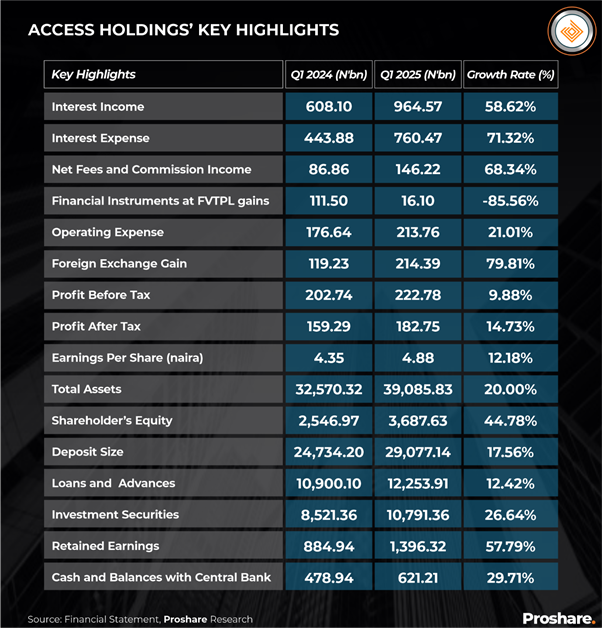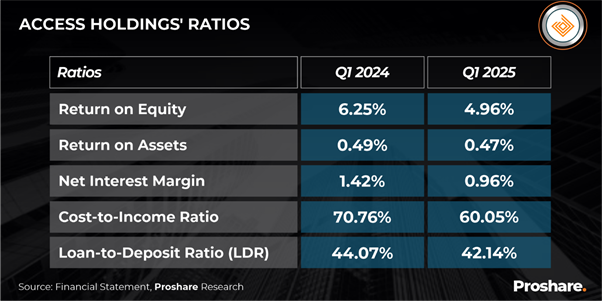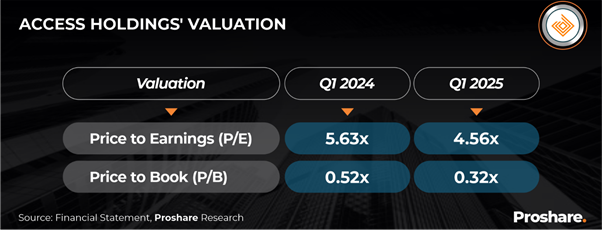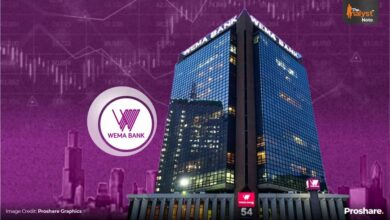Access Bank: Where Bigger Doesn’t Mean Better.

Despite its impressive asset growth, Access Bank’s inability to translate size into shareholder value raises alarming questions about its strategic priorities and management’s ability to drive sustainable returns ;its quater1 ,2025 results follow the same trend .
Access Bank, a banking giant with substantial resources, extensive distribution networks, and a strong reputation, exemplifies how size and resources, while crucial for success, don’t automatically guarantee superior value creation for shareholders or out-performance against competitors. As evidenced by its recent financials where impressive gross earnings growth didn’t proportionally translate to profitability growth, this bank has continued to highlight the complexities of leveraging size advantages to drive sustained success.
The truth hurts: Access Holdings’ efficiency falters when bench-marked against industry norms but shines when evaluated on its own historical progress – a comforting narrative for the bank’s backers.
With only 13.24 percent as its net profit margin , indicating only N13 of every N100 made of its N1.38trn revenue is converted to profit after tax in its 2025 first quarter results , the same it recorded at the end 2024 financial year , Access Bank leadership is yet to display a savvy to engender efficient performance. Consequently, poor valuation and low shareholders yield remain the biggest headache that afflict the biggest bank in Nigeria with N41trn assets as at the end of 2024 financial year . This paradox of plenty continues to worry shareholders.
In a sharp contrast to the Access Holdings miserable figure above , GTCO recorded 47.4percent at the end of the 2024 financial year as its net profit margin while Zenith Bank , United Bank for Africa and FirstBank Holdings registered 26percent , 24percent and 22percent respectively within the same period

Shareholders of Access Bank are growing increasingly concerned about the bank’s declining return on equity (ROE), assets (ROA), and net interest margin (NIM). Despite the bank’s impressive growth in gross earnings, its profitability metrics have failed to keep pace, raising questions about the effectiveness of its business model and management’s ability to generate returns for investors. The bank’s ROE, ROA, and NIM have all trended downwards, indicating that Access Bank is generating lower returns on its equity and assets, and facing pressure on its core lending business.
Access Bank’s Asset Dominance Fails to Translate to Market Value
Despite being Nigeria’s largest bank by assets, Access Bank’s market capitalization tells a different story. With a market cap of approximately ₦1.3 trillion, Access Bank lags behind its peers, Zenith Bank and GTCO, which have market caps of ₦2.361 trillion and ₦2.091 trillion, respectively. This disparity raises questions about Access Bank’s ability to translate its asset dominance into proportional value and outperform its competitors.The fact that United Bank for Africa (UBA) has a market cap of ₦1.79 trillion, higher than Access Bank’s, further underscores the bank’s challenges.
Possible Reasons for the Low Valuation
There are several possible reasons for Access Holdings’ low valuation. One reason is the company’s high debt levels, which have funded its rapid expansion. While this growth strategy may have benefits, it also comes at a cost to shareholders, who may not be seeing sufficient returns on their investment.
Another factor contributing to the low valuation may be the company’s relatively low dividend payouts. Access Holdings has a history of paying out smaller dividends compared to its peers, which could be deterring investors.
Access Bank’s valuation metrics suggest that its stock may be undervalued, but a closer look at its fundamentals reveals a more nuanced picture. The bank’s low price-to-earnings (P/E) ratio of 4.56x and price-to-book (P/B) ratio of 0.32x indicate that investors are pricing in underlying weaknesses. Compared to its peers, Access Bank’s financial performance may be lagging, leading to a discount in its valuation multiples. Potential areas of concern include slower growth in earnings or revenue, lower profitability margins, higher risk profile or asset quality issues, or inefficient capital allocation or utilization.
When compared to peers like Zenith Bank and Guaranty Trust Bank (GTCO), Access Bank’s fundamentals may appear weaker, justifying the lower valuation multiples. If these peers have stronger financial metrics, such as higher returns on equity (ROE) or return on assets (ROA), it would support the notion that Access Bank’s stock is undervalued due to its relatively weak fundamentals. This disparity in financial performance and valuation multiples suggests that investors are recognizing the differences in the banks’ underlying strengths and weaknesses.
Access Bank’s low valuation multiples may not be a buying opportunity, but rather a reflection of its underlying financial weaknesses. Investors should carefully evaluate the bank’s fundamentals and compare them to its peers before making any investment decisions. By understanding the drivers of Access Bank’s valuation, investors can make more informed choices about the stock’s potential for future growth.
This declining in profitability metrics is particularly worrisome given the bank’s significant growth in assets and deposits. Shareholders are likely to be anxious about the potential implications of these trends, including reduced dividend payments, decreased share price, and increased risk. With the banking sector facing intense competition and regulatory pressures, Access Bank’s management will need to take swift action to address these concerns and restore profitability. Failure to do so could lead to a loss of investor confidence and a decline in shareholder value, making it imperative for the bank’s leadership to prioritize strategic initiatives that drive long-term growth and profitability.
Access Bank’s Asset Dominance Over Others
The above development is ironical .In figure terms, at the end of 2024 financial year, Access Holdings delivered impressive total assets, surging 55.5% to N41.498 trillion, customer deposits growing 47% to N22.525 trillion, gross loans and advances rising 46.5% to N13.067 trillion, and shareholders’ funds jumping 72% to N3.760 trillion, showcasing robust growth and financial strength.
On quarterly basis, it is the same story. Access Bank’s financial performance for Q1 2025 is impressive, with total assets of ₦39.09 trillion, deposits grew 17.56% to ₦29,077.14bn, fueling a 12.42% rise in loan advances to ₦12,253.91bn and shareholder funds of ₦3.69 trillion.
Relative to its peers in the industry, with the above figures, Access Bank emerged the industry leader. For instance, at the end of the 2024 financial year, GTCO (Guaranty Trust Holding Company) reported total assets of ₦14.8 trillion and shareholders’ funds of ₦2.7 trillion. Loans to customers (net) amounted to ₦2.79 trillion, and deposit from customers (deposit liabilities) reached ₦10.40 trillion. Even zenith Bank , UBA and First Bank Holdings have dwarfed by it . GTCO’s Q1 2025 financial results showcase strong performance, with total assets of ₦15.9 trillion, customer deposits of ₦11.2 trillion (up 7.7% QoQ), loans and advances to customers of ₦3.22 trillion (up 15.6% QoQ), and shareholders’ funds of ₦3.0 trillion, demonstrating solid growth and financial stability

Revenue Dominance
Apart from its leadership in above, Access Bank’s capability to generate revenues is equally enormous. Access Holdings’ gross earnings of N4.878 trillion in 2024 more than doubled GTCO’s N2 trillion, with an impressive 88% year-on-year growth driven by significant increases in interest and non-interest income, showcasing Access Holdings’ dominant financial performance compared to GTCO’s strong but relatively modest earnings. Access Holdings’ Q1 2025 gross earnings (₦1.382 trillion) more than doubled GTCO’s (₦523.244 billion), reflecting a significant gap between the two banks’ revenue generation. While Access Holdings’ gross earnings surged 41.89% year-over-year, GTCO’s declined 23.1%. This divergence suggests Access Holdings is currently outpacing GTCO in terms of top-line growth.

With the above figures between the two bank ,Access Holdings, the parent company of Access Bank, has solidified its position as Nigeria’s largest bank, boasting the largest asset base, customer deposits, and loans to customers. While its shareholders’ funds may not be the largest, they remain highly competitive. This impressive strategic position is a testament to the company’s ability to leverage its strengths, resources, and capabilities to create a competitive advantage. With a strong market share, brand reputation, and innovative capabilities, Access Holdings is well-positioned to drive long-term growth and outperform its competitors in the Nigerian banking industry.
Miserable Profit: Overtaken By Its Peers By Wide Margins
The banking industry’s fundamental nature revolves around risk-taking, with lending being a crucial aspect. A bank’s ability to lend safely and profitably is a hallmark of good banking. Bank management, in essence, is risk management – navigating the complexities of asset-liability mismatches and interest rate differentials.
Access Bank’s financial performance raises concerns about its ability to maintain a competitive gap between lending and borrowing rates. Despite generating significant revenue, the bank’s profitability remains modest. This suggests that Access Bank may be struggling to optimize its interest income, a key driver of banking profitability.
The bank’s heavy revenue is not translating to substantial profits, likely due to the thin spread between borrowing and lending rates. This erodes the bank’s net interest income, a critical component of its profitability. To justify its substantial revenue, Access Bank must focus on maintaining a competitive interest rate gap, ensuring that its lending rates adequately compensate for the associated risks.
By doing so, Access Bank can improve its profitability and deliver stronger returns for its shareholders. The bank’s inability to achieve this highlights the challenges it faces in managing its risk profile and optimizing its financial performance. As the banking landscape continues to evolve, Access Bank must prioritize effective risk management and interest rate strategies to remain competitive.
Sequel to the above lapses ,Access Bank’s financial performance presents a paradox. Despite its impressive gross earnings of ₦4.878 trillion in 2024, a significant 88% surge from ₦2.594 trillion in 2023, the bank’s profit figures are disappointingly low. This raises concerns about its efficiency and profitability.
A comparison with its peers highlights the disparity. Zenith Bank emerged as the most profitable bank with a profit after tax (PAT) of ₦1.03 trillion, representing a 53% increase from 2023. GTCO also delivered an impressive performance, with a PAT of ₦1.02 trillion and a profit before tax of ₦1.266 trillion. First Bank’s PAT reached ₦663.4 billion, a 115.1% increase from the previous year.
In contrast, Access Bank’s PAT of ₦642.22 billion trails behind its peers, despite its substantial gross earnings. High interest expenses of ₦2.21 trillion and a relatively weak net interest income of ₦1.27 trillion likely contributed to the bank’s modest profitability. This disparity highlights the challenges Access Bank faces in translating its growth into profitability, particularly when compared to its peers.
While GTCO and First Bank demonstrated exceptional financial performance, Access Bank’s struggles with interest expenses and net interest income suggest that it still has work to do to optimize its financials and deliver stronger returns for its shareholders. As the banking sector continues to evolve, Access Bank will need to address these challenges to remain competitive with its peers.
The contrast between Access Bank’s gross earnings and profitability raises questions about its ability to efficiently manage its resources and generate strong returns. With its peers outperforming it despite having similar or lower resources, Access Bank must re-evaluate its strategy to improve its financial performance and competitiveness.
The leadership of Access Bank has not come to term with the fact that bigness without stretch and leverage is obesity just as smallness without a stretch and leverage is impotence. And the consequence of that negligence is clear enough: Access Bank’s impressive asset base and market dominance belie a concerning trend: an over-reliance on resource accumulation at the expense of resource leverage. Despite commanding a substantial market share and boasting significant gross earnings, the bank’s profitability lags behind. Its inefficient position is raising eyebrows, as peers with fewer resources are creating better value for their shareholders, sparking questions about the bank’s resource utilization and strategic priorities.
In the first quarter of the 2025 financial year, the situation is getting worse as indicated by its profitability ratios . Despite a 14.73% jump in profit after tax (PAT) to N182.83bn (from N159.29bn in Q1 2024) and a 9.88% growth in profit before tax (PBT) to N222.78bn, the bank’s net interest income took a hit, plummeting 20.13% to ₦220.21 billion due to a sharp 71.32% rise in interest expenses (₦760.47bn). Meanwhile, interest income soared 58.62% to ₦964.57bn, driven by higher yields on loans and securities. This dichotomy highlights the bank’s struggle to navigate the challenging economic landscape, where rising inflation and currency pressures are squeezing profit margins.
The bright spots in Access Bank’s Q1 2025 results: net fee and commission income skyrocketed 68.34% to ₦146.22bn, driven by credit-related fees and e-banking, while fair value and forex gains leaped 79.81% to ₦214.39bn, showcasing the bank’s stellar treasury and trading prowess. These non-interest income gains helped offset the decline in interest margins. Meanwhile, deposits grew 17.56% to ₦29,077.14bn, fueling a 12.42% rise in loan advances to ₦12,253.91bn. Retained earnings surged 57.79% to ₦1,396.32bn, underscoring the bank’s ability to generate wealth for its shareholders.
The pursuit of industry leadership is often misconstrued as a function of resource accumulation, but the reality is that resourcefulness trumps resources. A company’s ability to leverage its assets, talent, and intellectual energy is what truly fuels its journey to the future. To achieve , this , depends on the company’s strategic intent, an animating dream that provides emotional and intellectual energy and the driving force behind a company’s success. It’s not just about having a strong reputation, technological richness, or deep pockets; it’s about having a sense of direction, discovery, and destiny that inspires employees to work towards a common goal.
A well-defined strategic intent is broad enough to allow for experimentation, yet focused enough to ensure consistency in direction. It’s about creating a misfit between resources and aspirations, pushing the organization to stretch beyond its current capabilities. Companies like Toyota, which ventured into the luxury car business, and Bell Atlantic, which aimed to bring new information services to subscribers, demonstrate the power of strategic intent. By articulating a compelling destination, companies can evoke emotional appeal, inspire employees, and drive extraordinary efforts. Ultimately, it’s not the resources that determine a company’s success, but its resourcefulness and strategic intent.
The contrasting fortunes of Access Bank and GTCO illustrate the power of strategic intent and resource leverage. Access Bank, with its wealth of resources, has a modest aspiration to maintain its current position, while GTCO, despite its limited resources, has a grand ambition to knock its rivals off their leadership perch. This disparity in aspiration and resource allocation leads to fundamentally different approaches to competitive strategy. Access Bank, with its “slack” resources, adopts a traditional, resource-intensive approach, relying on its sheer size and wealth to overwhelm the competition. In contrast, GTCO, with its “stretch” resources, is forced to adopt a more innovative and efficient approach, leveraging its limited resources to outmaneuver Access Bank.
This scenario highlights the essence of resource leverage: doing more with less. GTCO’s resource-poor but aspiration-rich position drives creativity and innovation, allowing it to challenge Access Bank’s dominance. Meanwhile, Access Bank’s abundance of resources breeds complacency and inefficiency. The lesson is clear: having more resources doesn’t guarantee success; it’s the ability to leverage resources effectively that matters. By adopting a guerrilla warfare approach, GTCO can exploit Access Bank’s orthodoxies and complacency, ultimately gaining a competitive advantage. This underscores the importance of strategic intent and resourcefulness in driving industry leadership.
Access Holdings, the parent company of Access Bank, has grown rapidly over the years, becoming Nigeria’s largest bank by assets. However, despite its growth, the company’s market value is surprisingly low compared to its peers. In fact, it’s valued less than its main competitors, Zenith Bank and GTCO.
In simple terms, Access Holdings has grown a lot, but its value isn’t reflected in its market price. Investors are waiting to see if the company can deliver returns on their investment and increase its value.
But the bank’s leadership appears to be retracing its step . Recently, Aigboje Aig-Imoukhuede, chairman of Access Holdings, hinted at a shift in strategy, stating that the company plans to slow down its expansion drive and focus on consolidating its recent acquisitions. This move suggests that the company is aware of the need to prioritize resourcefulness and create value for shareholders. As Access Holdings proceeds with its plans, investors will be watching closely to see if the company can deliver on its promises and increase its market value. Can Access Bank prove its resourcefulness and increase its market value? Only time will tell.




